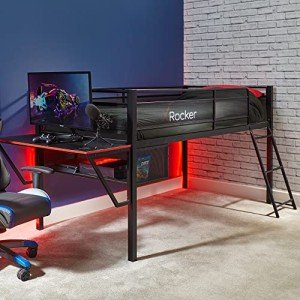Bunk Beds for Kids: A Comprehensive Guide
Bunk beds have actually been a popular option for kids's bedrooms for many years. They provide a space-saving solution that optimizes flooring location, offers fun climbing options, and is available in a range of styles that attract kids's creativities. This post explores the benefits, factors to consider, styles, and safety features connected with bunk beds for children.
Benefits of Bunk Beds
Bunk beds present several advantages that make them an attractive alternative for families. Here are some crucial benefits:
Space Saving
- Bunk beds enable two or more kids to share a space without compromising space for play or other activities.
Affordable
- Getting a single bunk bed can be more cost-effective than buying two different beds.
Enjoyable Factor
- Kids typically see bunk beds as an enjoyable location to sleep and play, promoting a sense of adventure.
Flexibility
- Bunk beds are offered in various configurations, consisting of L-shaped, loft beds, and even convertible designs that can change as kids grow.
Organization
- Numerous bunk beds come with integrated storage options, such as racks and drawers, helping keep rooms organized.
Secret Considerations Before Purchasing
Before buying a bunk bed, it's essential to think about certain aspects, such as:
- Space Requirements
Procedure the space to make sure that there is enough vertical space, allowing for adequate headroom on the top bunk. - Age of Your Children
Consider their age and maturity. Many producers suggest that kids under 6 ought to not sleep in the leading bunk due to safety issues. - Weight Limit
It's essential to examine the weight limitations of the bunk bed for both the leading and bottom bunks to ensure safety. - Style Preferences
Choose a style that matches the room's decoration and the children's choices. - Product
Bunk beds are available in numerous products, such as wood or metal. Each has its benefits and drawbacks regarding durability and looks.
Styles of Bunk Beds
Bunk beds come in various designs to fit different visual appeals and functional needs. Here's a list of some popular styles:
- Standard Bunk Beds
Traditional stacked beds that include 2 beds constructed one above the other. - Loft Beds
A bed raised high off the ground, with space underneath for a desk, play location, or storage. - L-Shaped Bunk Beds
2 beds set up in an L-shape, offering more flooring space and a special style aspect. - Twin Over Full Bunk Beds
These options include a twin bed on top and a full-sized bed on the bottom, accommodating older children or adults. - Triple Bunk Beds
Developed for 3 children, these beds usually include 3 stacked beds, perfect for bigger families.
Safety Features to Consider
Ensuring the safety of kids utilizing bunk beds is vital. Here are some safety includes to search for before purchasing:
- Guardrails
A bunk bed need to consist of sturdy guardrails on the leading bunk to prevent unexpected falls. - Ladders
Ensure that the ladder is firmly connected and easy for children to browse safely. - Stability
Search for bunk beds with lower centers of gravity and broad bases to offer better stability. - Quality Construction
Pick beds made from long lasting products that meet security requirements, such as ASTM (American Society for Testing and Materials) policies.
Frequently Asked Questions About Bunk Beds
1. What age is appropriate for a top bunk?Generally, Best Rated Bunk Beds aged six and older are advised for sleeping in the top bunk. 2. Are bunk beds safe for toddlers?Most experts encourage against
positioning toddlers in the top bunk due to the
risk of falls and incorrect ladder use. 3. Can bunk beds be separated?Many bunk beds are designed to be separated into two standalone beds,
providing added flexibility as kids grow
. 4. How do I maintain a bunk bed?Regularly look for loose screws and use, keep mattresses tidy, and guarantee that the bunk bed is
steady to lengthen its lifespan. 5.
Exist any special bed mattress requirements for bunk beds?Yes, mattresses for bunk beds ought to fit snugly without leaving gaps. Normally, thinner mattresses
(around 6 to 8 inches )are suggested for top bunks for safety. Bunk beds offer a flexible, practical, and fun option for children's sleeping arrangements, maximizing space while accommodating several kids in one room. By considering the essential elements
of design, safety, and space, moms and dads can make a notified decision when picking the best bunk bed for their kids's requirements. With the best care and maintenance, a bunk bed can be a cherished furniture piece that offers years of usage and pleasure for children. Summary Table of Bunk Bed Styles Design Description Best For Standard Bunk Beds Timeless style, 2 stacked beds Smaller sized rooms Loft Beds Elevated bed with open space below Study or play areas L-Shaped Bunk Beds 2 beds in an L-shape
Included flooring space Twin Over Full Twin on leading,
| complete on bottom Accommodating older kids Triple | ||||||
|---|---|---|---|---|---|---|
| Bunk Beds | Three stacked beds | Larger households By understanding | the numerous alternatives available, designated considerations for security and functionality, and proper age guidelines, households | can select the perfect bunk bed that not | only boosts their living space | but likewise ensures a safe and |
| enjoyable sleeping environment | for their children.

|
